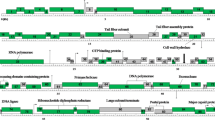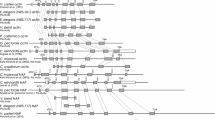Summary
Physarum polycephalum (strain M3CVIII) contains four unlinked actin gene loci, each with two alleles (ard A1, ard A2, ard B1, ard B2, ard C1, ard C2, ard D1 and ard D2). The 4.8 kbp HindIII component of the ard C2 locus was isolated as a recombinant phage-λ, after HindIII fragments of Physarum DNA ranging from 4.3 kbp to 5.5 kbp were cloned into phage-λ NM1149. The fraction of Physarum DNA cloned contained the ard C locus, and no other actin locus. Small inserts were favoured to reduce the probability of cloning a complete repetitive element, because such elements have been found to adversely affect the stability of recombinants.
The coding sequences of the actin gene (approximately 1.1 kbp) spanned more than 3 kbp indicating the presence of introns. A 1.6 kbp HindIII/EcoRI fragment of the ard C locus, which contained some coding sequences, hybridized extensively with HindIII fragments of genomic DNA indicating the presence of repetitive sequences. A 2.3 kbp HindIII/EcoRI fragment containing most of the coding sequences of the C2 allele of the ard C locus hybridized with the C1, allele and both alleles of the ard B locus, but not with the ard A locus or ard D locus. This distinction was used to establish for the ard B and ard C loci the relationship between the EcoRI and HindIII fragments that define an ard locus. The ability to distinguish between ard loci may facilitate studies of the expression of particular actin loci.
Similar content being viewed by others
References
Alexopoulos CJ (1982) Morphology, taxonomy and phylogeny. In: Aldrich HC, Daniel JW (eds) Cell biology of Physarum and Didymium, vol 1. Academic Press, New York, p 3
Benton WD, Davis RW (1977) Screening gt recombinant clones by hybridization to single plaques in situ. Science 196:180–182
Cox RA, Smulian NJ (1983) A single-step procedure for the isolation of individual mRNA species from crude lysates of Physarum polycephalum. FEBS Lett 155:73–80
Daniels DL, De Wet JR, Blattner FR (1980) New map of bacteriophage lambda DNA. Virology 33:390–400
Denhardt DT (1966) A membrane-filter technique for the detection of complementary DNA. Biochem Biophys Res Commun 23:641–646
Dretzen G, Bellard M, Sassone-Corsi P, Chambon P (1981) A reliable method for the recovery of DNA fragments from agarose and acrylamide gels. Anal Biochem 112:295–298
Fyrberg EA, Kindle KL, Davidson N, Sodja A (1980) The actin genes of Drosophila: a dispersed multigene family. Cell 19:365–378
Greene PJ, Betlach MC, Boyer HW, Goodman HM (1974) In: Wickner RB (ed) Methods in molecular biology: DNA replication and biosynthesis, vol 7. Marcell Dekker Inc, New York, p 87
Hardman N, Jack PL, Fergie RC, Gerrie LM (1980) Sequence organisation in nuclear DNA from Physarum polycephalum. Eur J Biochem 103:247–257
Kessler D (1982) Plasmodial structure and mobility. In: Aldrich HC, Daniel JW (eds) Cell biology of Physarum and Didymium, vol 1. Academic Press, New York, p 145
Kleinsmith LJ, Peters K, Zeigler ME (1984) Regulation of nonmuscle actin gene expression during early development. In: Stein GS, Stein JL (eds) Recombinant DNA and cell proliferation. Academic Press, New York, p 273
Laemmli UK (1970) Cleavage of structural proteins during the assembly of the head of bacteriophage T4. Nature 227:680–685
Laskey RA (1980) The use of intensifying screens or organic scintillators for visualizing radioactive molecules resolved by gel electrophoresis. In: Grossman L, Moldave K (eds) Methods in enzymology, vol 65. Academic Press, New York, p 363
Maniatis T, Fritsch EF, Sambrook J (eds) (1982) Identification of cDNA clones by hybridization selection. In: Molecular Cloning. A laboratory manual. Cold Spring Harbor Laboratory, New York, p 329
Meinkoth J, Wahl G (1984) Hybridization of nucleic acids immobilized on solid supports. Anal Biochem 138:267–284
Mohberg J, Rusch HP (1971) Isolation and DNA content of nuclei of Physarum polycephalum. Exp Cell Res 66:305–316
Murray NE (1983) Phage lambda and molecular cloning. In: Hendrix RW, Roberts JW, Stahl FW, Weisberg RA (eds) Lambda II. Cold Spring Harbor Laboratory, New York, p 395
Nader WF, Edlind TD, Huettermann A, Sauer HW (1985) Cloning of Physarum actin sequences in an exonuclease-deficient bacterial host. Proc Natl Acad Sci USA 82:2698–2702
Pahlic M (1985) Multiple forms of actin in Physarum polycephalum. Eur J Cell Biol 36:169–175
Rigby PWJ, Dieckmann M, Rhodes C, Berg P (1977) Labelling deoxyribonucleic acid to high specific activity in vitro by nick translation with DNA polymerase I. J Mol Biol 113:237–251
Sager R, Anisowicz A, Howell N (1981) Genomic rearrangements in a mouse cell line containing integrated SV40 DNA. Cell 23:41–50
Scalenghe F, Turco E, Edstrom JE, Pirrotta V, Melli M (1981) Microdissection and cloning of DNA from a specific region of Drosophila melanogaster polytene chromosomes. Chromosoma 82:205–216
Schedl T, Dove WF (1982) Mendelian analysis of the organization of actin sequences in Physarum polycephalum. J Mol Biol 160:41–57
Schedl T, Owens J, Dove WF, Burland TG (1984) Genetics of the tubulin gene families of Physarum. Genetics 108:143–164
Southern EM (1975) Detection of specific sequences among DNA fragments separated by gel electrophoresis. J Mol Biol 98:503–517
St John TP, Davis RW (1979) Isolation of galactose-inducible DNA sequences from Saccharomyces cerevisiae by differential plaque filter hybridization. Cell 16:443–452
Wilhelm ML, Wilhelm F-X (1984) A transposon-like DNA fragment interrupts a Physarum polycephalum histone H4 gene. FEBS Lett 168:249–254
Yamamoto KR, Alberts BM, Benzinger R, Lawhorne L, Treiber G (1970) Rapid bacteriophage sedimentation in the presence of polyethylene glycol and its application to large-scale virus purification. Virology 40:734–744
Author information
Authors and Affiliations
Additional information
Communicated by C. Auerbach
Rights and permissions
About this article
Cite this article
Monteiro, M.M., Cox, R.A. Characterization of ard B and ard C actin gene loci of Physarum polycephalum . Molec Gen Genet 204, 153–160 (1986). https://doi.org/10.1007/BF00330203
Received:
Issue Date:
DOI: https://doi.org/10.1007/BF00330203




